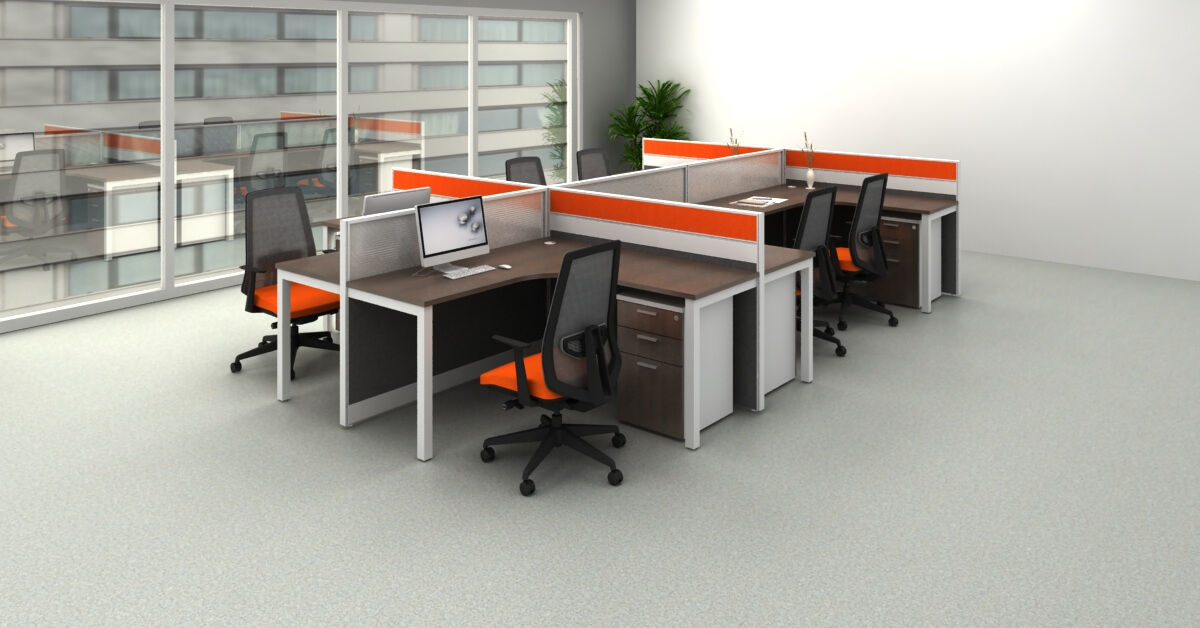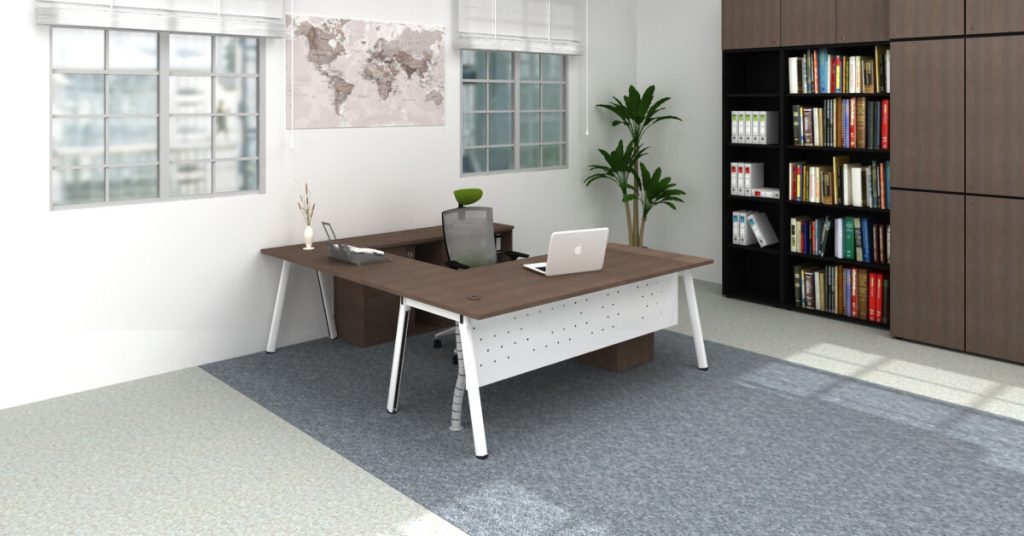
19 Feb Choosing the Ideal Material for Corporate Office Furniture: A Comprehensive Guide
How does the choice of materials impact the efficiency and aesthetics of your office space? Selecting the right materials for office furniture and workstations isn’t just about enhancing the visual appeal of your workspace; it’s about creating an environment that fosters productivity, comfort, and sustainability. From the durability of desks to the comfort of chairs, each material offers distinct benefits and challenges, making understanding their properties crucial for any business aiming to optimize their office environment.
This article guides you on choosing the best materials for office furniture. It discusses different materials like wood, metal, and more, focusing on their benefits for office use. You’ll learn how to pick materials based on durability, look, and cost, ensuring your office is both functional and stylish.
What Should You Consider When Selecting Materials for Office Furniture?
When choosing materials for office furniture, consider durability to ensure longevity, aesthetics for a cohesive look, maintenance for easy care, and environmental impact for sustainability. These factors help balance practicality with design, making your office both functional and inviting.
- Durability: Choose materials like solid wood or metal for desks and chairs, as they are known for their strength and longevity, making them ideal for high-traffic areas.
- Aesthetics: Materials such as glass or polished wood can add a modern or sophisticated touch to your office, enhancing the overall look and feel of the workspace.
- Maintenance: Opt for laminate or veneer finishes for easy-to-clean surfaces that resist stains and scratches, keeping your office looking pristine with minimal effort.
- Environmental Impact: Consider eco-friendly materials like bamboo or recycled plastics, which offer sustainability benefits, reducing your office’s carbon footprint and supporting green initiatives.
- Size: Ensure the desk fits comfortably in your workspace and leaves room for other equipment.
- Material: Choose from wood, metal, glass, or plastic, considering durability and style.
- Shape: Select rectangular, L-shaped, U-shaped, or circular desks based on workspace size and work type.
- Storage: Determine if you need drawers, shelves, or cabinets for office supplies and files.
- Style: Match the desk’s aesthetic with your office decor and personal taste.
- Ergonomics: Opt for desks with adjustable height and comfortable seating to prevent strain.
- Price: Balance your budget with the desk’s value, as higher price doesn’t always mean better quality.
When picking out a desk for your workspace in Malaysia, it’s important to consider several factors. First, think about the size of the desk to ensure it fits comfortably and leaves enough space for other office equipment. Next, evaluate the material options like wood, metal, glass, or plastic, considering both durability and style. Then, decide on the shape—whether it’s rectangular, L-shaped, U-shaped, or circular—based on your workspace size and the type of work you’ll be doing. Also, take into account your storage needs for office supplies and files, and look for desks with drawers, shelves, or cabinets. Don’t forget about style—choose one that complements your office decor and reflects your personal taste.
Additionally, prioritize ergonomics by selecting desks with adjustable height and comfortable seating to prevent back pain. Lastly, consider your budget and aim for desks that offer good value for money, as a higher price doesn’t always guarantee better quality.
What Materials are used in Office Workstations?
Choosing the right materials for corporate office furniture is essential for durability, aesthetics, and functionality. From traditional wood to modern metals and innovative plastics, each material offers unique benefits. High-pressure laminates provide stylish options for those on a budget, while softer materials like mesh and felt add comfort. Let’s explore these materials in detail to understand their advantages and applications in office environments.
- Metal: Metal office furniture, known for its strength, is enhanced by materials like steel, providing durability and a modern appeal. Designed for high-traffic areas, these pieces withstand daily use.
- Wood: Wood offers durability and a classic aesthetic, with various types like oak, pine, and exotic woods such as teak. Customizable through stains or paints, it matches office decor, ensuring versatility and longevity.
- Glass: Glass desks, versatile and durable, create an airy office space ambiance. Strong enough to withstand daily use and minor accidents, they enhance productivity with a pleasant work environment.
- High-Pressure Laminate: This furniture choice offers quality and style, providing a fashionable look with numerous color options. Serving decorative and functional purposes, it’s ideal for office settings.
- Plastic: High-quality plastics like polypropylene offer strength, versatility, and vibrant color finishes, ensuring functional and visually appealing office furniture.
- Mesh and Felt: Chairs and furniture pieces incorporate mesh, felt, and upholstery for increased comfort. Mesh offers support and aesthetic appeal, while upholstery adds style and fixed cushioning. Felt is used in acoustic panels to reduce noise.
- Polyester: Office furniture crafted from polyester offers durability and easy maintenance, resisting stretching, shrinking, and wrinkling over time.
- Nylon: Dyed nylon fabric provides strength and stain resistance for robust office chairs, also resisting pilling, abrasion, and fraying.
- Rayon: Rayon, a versatile semi-synthetic fiber, enhances office furniture with its cool, absorbent, and soft texture, providing a pleasant seating experience.
- Acrylic: Acrylic fabric, resistant to water, mildew, and chemicals, ensures long-lasting performance in office furniture, remaining durable and dye-friendly.
- Vinyl: Vinyl chairs, low-maintenance and durable, offer various textures and softness levels, maintaining aesthetic appeal over time in any office setting.
The quality of office furniture is crucial. Durable materials and fibers save costs in the long run. Now that you’re aware of the top materials and fabrics for office furniture, you can select one or two for a comfortable office experience.

Special Materials for Specific Furniture
Certain materials excel in specific furniture pieces, balancing functionality with aesthetics. Ergonomic chairs prioritize breathable mesh for comfort, while desks and meeting tables often boast high-pressure laminates for enduring durability and style. Executive offices typically favor the timeless elegance of wood or wood veneer, offering a range of finishes to match their sophistication. For outdoor settings, polypropylene or polymer are preferred for their weather-resistant properties, ensuring both durability and design versatility.
An ergonomic workstation aims to maximize comfort and productivity, with adjustable chairs, desks, and equipment positioned to reduce strain. Features like adjustable monitor stands and ergonomic keyboards personalize the workspace, promoting better health and efficiency.
High-pressure laminates are popular for desks and meeting tables due to their resilience against scratches and stains. Offering a variety of designs and colors, they combine practicality with aesthetics for enduring office furniture.
Executive offices often opt for wood or wood veneer, appreciating their classic appeal and durability. With a range of finishes available, from natural grains to polished sheens, these materials allow for customization, reflecting the executive’s unique style and status.
Outdoor furniture relies on polypropylene or polymer for their ability to withstand diverse weather conditions without losing their charm. Lightweight and flexible, they offer various color options and easy rearrangement, perfect for creating inviting outdoor workspaces.
Matching Office Furniture Materials to Office Needs
Matching office furniture materials to office needs is crucial for ensuring the workspace is both functional and aesthetically pleasing. It involves selecting materials that suit the specific demands of different areas within the office, considering factors like durability for high-traffic zones, visual appeal for client-facing areas, and comfort for employee workspaces. This alignment enhances productivity, reflects the company’s brand, and contributes to a sustainable office environment by choosing materials that are both durable and environmentally friendly.
In Conclusion
Selecting the right materials for office furniture enhances the workspace, balancing functionality with design. This guide covers wood, metal, glass, and innovative materials, each catering to specific office needs. We delve into considerations like durability, aesthetics, and sustainability, ensuring your choices reflect your brand and contribute to a productive environment. From ergonomic chair to office workstations to executive offices and outdoor spaces, understanding the right materials for each furniture piece is key to creating a comfortable, stylish, and efficient office setting.
Ready to elevate your office with the best furniture materials? Explore our guide and make informed choices for a stylish and functional workspace. Contact us for advice!

Sorry, the comment form is closed at this time.